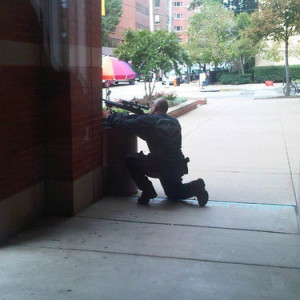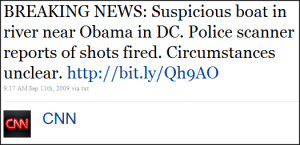Baltimore Sun reporter Justin Fenton is receiving praise for his Twitter coverage of the deadly shooting at Johns Hopkins Hospital last week. Fenton reported what he heard on the police scanner, attributing those tweets to the scanner and stating when reports were unconfirmed.
On Press Check, Baltimore Magazine‘s blog that covers local media, senior editor Evan Serpick writes:
Fenton was a tweet machine, passing along crucial information as it came to him, whether through official sources, his own observations, or overheard chatter on police scanners and conversations. His dozens of tweets in the hours after the shooting providing the most accurate real-time account of what was happening. Fenton was interviewed on CNN fairly early in the ordeal and became the outlet’s best source for accurate info.
 Many news outlets, even online, don’t use scanner as a source because the information can often be unreliable. Inaccurate reports can be detrimental, particularly when sourced from respected national organizations. CNN experienced this last year on September 11 when it erroneously tweeted about shots fired near President Obama from a suspicious boat. The scanner chatter turned out to be about a U.S. Coast Guard training exercise, but before that fact was discovered, numerous other news outlets had repeated CNN’s report, D.C. police and federal agents flocked to the scene, and even flights were delayed.
Many news outlets, even online, don’t use scanner as a source because the information can often be unreliable. Inaccurate reports can be detrimental, particularly when sourced from respected national organizations. CNN experienced this last year on September 11 when it erroneously tweeted about shots fired near President Obama from a suspicious boat. The scanner chatter turned out to be about a U.S. Coast Guard training exercise, but before that fact was discovered, numerous other news outlets had repeated CNN’s report, D.C. police and federal agents flocked to the scene, and even flights were delayed.
Another reason for avoiding scanner sourcing is to avoid compromising tactical information during emergency situations. For example, a couple of commenters on Fenton’s TwitPic of the Johns Hopkins incident questioned the responsibility of posting a sniper’s photo before the assailant had been captured or killed.
 Citizen journalists and activists are tweeting scanner information, too. Self-described anarchist Elliot Madison was arrested last year for tweeting about police locations during protests of the G-20 summit in Pittsburgh. Madison used police scanners to provide the information so that protesters could avoid law enforcement. He was charged with “hindering apprehension or prosecution, criminal use of a communication facility and possession of instruments of crime,” and items such as computers, cell phones, and books were seized from his home by federal agents.
Citizen journalists and activists are tweeting scanner information, too. Self-described anarchist Elliot Madison was arrested last year for tweeting about police locations during protests of the G-20 summit in Pittsburgh. Madison used police scanners to provide the information so that protesters could avoid law enforcement. He was charged with “hindering apprehension or prosecution, criminal use of a communication facility and possession of instruments of crime,” and items such as computers, cell phones, and books were seized from his home by federal agents.
It is important for Canadians to be guided by the basic information about Winnipeg’s small claims court. From hearings to the disputes covered, the residents must be aware of certain rules and regulations. The small claims court in Manitoba is covered by the Manitoba Court of Queen’s bench.
Sandra Charlier Fish, a journalism instructor at the University of Colorado, began tweeting police scanner reports on September 6 when she started seeing signs of the Fourmile Canyon fire from her the window of her home. “I tweeted about which areas they were evacuating, and when they lost structures,” she said. Despite criticism of her scanner tweeting efforts, Fish said:
Scanner traffic is law enforcement people talking to each other. It’s not always end results, but it’s what’s happening right now. The mainstream media need to learn to be more nimble. In the information age, people want immediate information. I don’t think the mainstream media are getting the news out fast enough.
Fish feels that journalism education should include live tweeting as a reporting tool. She already teaches it to students in her Principles of Journalism class. Based on her classes and her experiences with the Fourmile Canyon fire, Fish offers these tips for reporting via Twitter:
- Use visuals such as Google Maps, Flickr, TwitPic, and YouTube.
- Use hashtags, and keep them uniform with what others are using for the same event.
- Rotate scanner monitors every hour or so staff members don’t become exhausted.
- Be familiar with Twitter before the crisis occurs. Don’t try to learn Twitter while also trying to cover an emergency situation.
- Establish guidelines ahead of time for what you will and won’t tweet and how you will correct errors.
Source: “Baltimore Media Shine in Hopkins Coverage,” Baltimore Magazine‘s Press Check, 09/17/10
Source: “Tweeting the scanner from a breaking story,” Lost Remote, 09/16/10
Source: “Radio Traffic Led to False News Reports of Gunfire on Potomac,” The Washington Post, 09/11/09
Source: “An Interview with the Tweeting Anarchist, Elliot Madison,” The Village Voice, 11/10/09
Source: “Scanner tweeting: Breaking news lessons from the Boulder fire,” Knight Digital Media Center’s News Leadership 3.0 blog, 09/09/10
Image by Justin Fenton for the The Baltimore Sun, used via TwitPic.